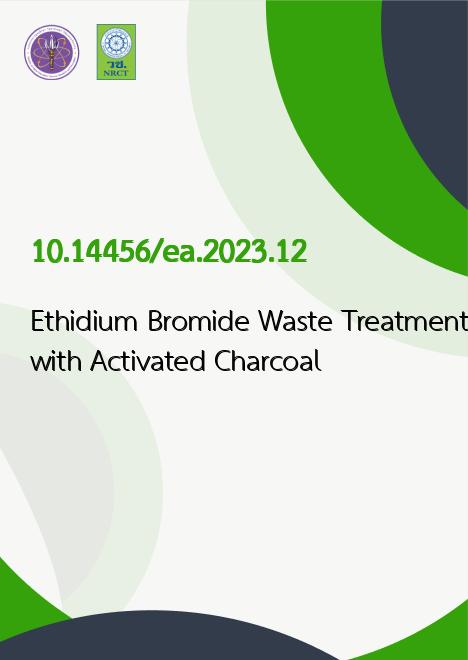
|
Ethidium Bromide Waste Treatment with Activated Charcoal |
|---|---|
| รหัสดีโอไอ | |
| Creator | 1. Siska Novania 2. Adhana Riyadani Putri Widagdo 3. Dita Meilia Prihatiningrum 4. Shifa Fauziyah 5. Teguh Hari Sucipto |
| Title | Ethidium Bromide Waste Treatment with Activated Charcoal |
| Publisher | Thai Society of Higher Education Institutes on Environment |
| Publication Year | 2566 |
| Journal Title | EnvironmentAsia |
| Journal Vol. | 16 |
| Journal No. | 1 |
| Page no. | 138-145 |
| Keyword | Ethidium bromide, Chemical waste, Activated charcoal, Waste treatment, Adsorption |
| URL Website | http://www.tshe.org/ea/index.html |
| Website title | EnvironmentAsia |
| ISSN | 1906-1719 |
| Abstract | Ethidium bromide (EtBr) is a chemical agent commonly used to identify and visualize thebonding of DNA and RNA in molecular biology research. However, ethidium bromide itselfis mutagenic and toxic. Ethidium bromide also has carcinogenic properties to human cells,teratogenic, and difficult to decompose. Therefore, a research for the treatment of EtBr wasteis very important. There are several materials that can be used to reduce EtBr waste, butthere is also needed a material which is cheap and widely available in the market. One of themethods to treat ethidium bromide waste is using activated charcoal. Activated charcoal hasstrong adsorption capacity due to its high surface area and porous structure. Another advantageof activated charcoal as an adsorbent is economical, effective, and environmentally friendly.In this study, EtBr waste was mixed with activated charcoal then homogenized for one hour.The mixing of EtBr waste (0.5 mg/mL concentration of EtBr) and activated charcoal was variedwith a ratios weight by volume of 1:1, 1:2, and 2:1. The mixture of the solution was filteredusing Whatmann filter paper No.1 to take the filtrate. The filtrate was further analyzed. Themore activated charcoal was added, the more EtBr molecules were adsorbed. The pH in thefiltration results for each variation was pH 7.0 - 8.0, dissolved oxygen with range 5.0 - 9.0 mg/L,biochemical oxygen demand (BOD) with range 25.06 - 78.2 mg/L, and chemical oxygen demand(COD) with range 302.56 - 310.98 mg/L. The concentration range was obtained as follows, for a1:1 ratio of 0.045 - 0.060 mg/mL, for a 1:2 ratio of 0.028 - 0.032 mg/mL, while a 2:1 ratio of 0.081- 0.090 mg/mL. In addition, the results showed that activated charcoal was able to bind Ethidiumbromide due to bond interactions that occur between the EtBr molecule and activated charcoal. |